Spinal stenosis is characterized by narrowing spaces within the spine, which can pressure the nerves travelling through the spine. This narrowing often leads to symptoms such as pain, numbness, muscle weakness, and difficulty with mobility, primarily in the lower back and legs. Common causes of spinal stenosis include age-related wear and tear, arthritis, or congenital conditions that affect spinal structure.
For individuals living with spinal stenosis, maintaining physical activity can be challenging yet essential. Exercise is crucial in managing symptoms, improving flexibility, and strengthening the muscles that support the spine. However, not all forms of exercise are suitable, as high-impact activities may exacerbate symptoms.
Cycling, as a low-impact exercise, is often recommended for those with spinal stenosis due to its gentle effect on the joints and spine. Unlike running or other high-impact activities, cycling reduces the risk of additional strain on the lumbar region while promoting cardiovascular health and muscular endurance.
Exploring whether is cycling good for spinal stenosis requires understanding its potential benefits and limitations. By choosing the right exercise approach and consulting healthcare professionals, individuals can find a regimen that supports spinal health without worsening symptoms.
Benefits of Cycling for Spinal Stenosis
Cycling is often praised as one of the best low-impact exercises for individuals managing chronic conditions like spinal stenosis. Its unique benefits make it an appealing option for maintaining physical activity without worsening spinal symptoms. The gentle nature of cycling minimizes strain on the lumbar spine while providing significant health advantages.
One of the primary benefits of cycling is its ability to promote cardiovascular health. Regular cycling improves blood flow, helping deliver oxygen and nutrients to the spinal discs and surrounding muscles. Additionally, cycling helps to strengthen the lower body, particularly the glutes, hamstrings, and quadriceps, which are essential for supporting spinal stability and reducing pressure on the lower back. Another significant advantage is the flexibility it encourages in the hips and lower back, which often become tight or stiff in individuals with spinal stenosis.
Key Benefits of Cycling for Spinal Stenosis
- Low-Impact Nature: Reduces joint and spine stress, making it ideal for individuals with chronic conditions.
- Improved Cardiovascular Health: Enhances blood circulation, benefiting the spinal discs and overall health.
- Lower Body Strengthening: Targets muscles that stabilize the spine and reduce spinal compression.
- Flexibility Improvement: Encourages range of motion in the hips and lower back, easing tension in these areas.
- Joint Lubrication: Promotes movement in the knee and hip joints without excessive wear and tear.
While cycling has numerous benefits, its true value lies in its adaptability to individual needs. People can control the intensity of their workouts, opting for gentle pedalling on flat terrain or moderate cycling on stationary bikes. This versatility allows individuals with spinal stenosis to stay active without compromising their spinal health.
In addition to its physical benefits, cycling contributes to mental well-being. Regular exercise has been shown to reduce stress and improve mood, which is especially beneficial for those managing chronic pain or discomfort. By incorporating cycling into a fitness routine, individuals can experience a holistic improvement in their physical and mental health.
Risks and Considerations When Cycling with Spinal Stenosis
While cycling can be beneficial for individuals with spinal stenosis, it is not without its risks. Understanding potential challenges and taking precautions can ensure a safe and effective experience. One of the most common issues is an improper bike fit. When the seat height, handlebar position, or pedal alignment is not adjusted correctly, it can lead to poor posture, which may aggravate spinal symptoms. Maintaining the correct alignment during cycling is critical to avoiding additional strain on the lower back.
Overtraining is another consideration. Even low-impact exercises like cycling can cause muscle fatigue or worsen discomfort if done excessively or without adequate rest. People with spinal stenosis need to listen to their bodies and avoid pushing beyond their physical limits. Gradually increasing the intensity and duration of cycling sessions is essential to avoid injury or flare-ups.
Additionally, incorrect cycling posture, such as hunching over the handlebars or hyperextending the spine, can put undue stress on the back and neck. Proper posture involves maintaining a neutral spine, with shoulders relaxed and the back supported by strong core muscles. Consulting a professional for bike fitting or posture correction can significantly reduce these risks.
When considering whether is cycling good for spinal stenosis, individuals must weigh these potential challenges against its benefits. By addressing these risks proactively—such as by investing in professional guidance for bike adjustments or starting with low-intensity sessions—cycling can remain a safe and effective option for managing spinal stenosis symptoms.
Proper Cycling Techniques for Spinal Stenosis Patients
Proper cycling techniques are essential for individuals with spinal stenosis to ensure that exercise remains safe and effective. Making the right adjustments to your bike and adopting the correct posture can significantly reduce strain on the lumbar spine, improve comfort, and enhance overall benefits. These adjustments help distribute body weight evenly, minimizing the risk of aggravating symptoms.
One of the first steps is ensuring your bike is correctly fitted. The seat height should allow a slight bend in the knee when the pedal is at its lowest point. Handlebars should be positioned to prevent excessive leaning forward, which can pressure the lower back. Additionally, maintaining a neutral spine during cycling is critical. This posture ensures that the back is neither overly curved nor excessively straightened, allowing for optimal support from surrounding muscles.
Warm-up and cool-down stretches are also crucial before and after cycling sessions. These stretches help prepare the body for physical activity and reduce muscle tightness afterwards, promoting flexibility and reducing stiffness in the lower back and hips.
Recommended Adjustments and Techniques for Cycling with Spinal Stenosis
| Adjustment/Technique | Description |
| Seat Height | Ensure a slight knee bend at the pedal’s lowest point. |
| Handlebar Position | Adjust to maintain an upright posture and reduce strain. |
| Cycling Intensity | Start with low resistance and short durations (10–15 mins). |
| Warm-Up Stretches | Perform 5–10 minutes of light stretches for hips and spine. |
| Cool-Down Stretches | Focus on hamstrings, lower back, and hip flexors. |
These adjustments and techniques are easy to implement and significantly improve comfort and safety while cycling. For example, adjusting the seat height reduces pressure on the knees and lower back, allowing for a smoother pedalling motion. Similarly, setting the handlebars at the correct height prevents slouching and maintains a neutral spine, which is crucial for avoiding additional strain.
Incorporating warm-up and cool-down routines further enhances the benefits of cycling. Stretching improves flexibility and reduces the risk of injury, helping spinal stenosis patients achieve a more sustainable and comfortable workout routine.
Alternative Low-Impact Exercises for Spinal Stenosis
While cycling is a popular low-impact exercise for managing spinal stenosis, other activities can also benefit those looking to stay active while protecting their spine. Each alternative offers unique advantages that cater to different needs and preferences, making them excellent options when cycling may not be suitable.
Swimming, for example, is a highly effective low-impact exercise that minimizes joint and spine pressure. The buoyancy of water reduces body weight, allowing for gentle movement and muscle engagement without strain. Activities like water aerobics or swimming laps promote flexibility, improve cardiovascular health, and strengthen core and back muscles.
Yoga is another excellent choice for individuals with spinal stenosis. It emphasizes controlled movements and stretches that improve flexibility and balance. Gentle yoga poses, such as the cat-cow stretch or child’s pose, can help alleviate tension in the lower back and hips, making it an ideal complement to other low-impact exercises.
Though often overlooked, walking is one of the most straightforward and accessible forms of exercise for spinal stenosis patients. It helps improve circulation, strengthen the muscles supporting the spine, and enhance overall mobility. Walking outdoors also offers mental health benefits by reducing stress and improving mood, which is especially valuable for chronic pain patients.
While exploring whether is cycling good for spinal stenosis, it’s essential to consider these alternatives as part of a comprehensive fitness routine. Each activity provides unique benefits, and alternating between cycling and other low-impact exercises can prevent overuse injuries and maintain motivation. Consulting with a healthcare provider can help determine the most appropriate exercises based on individual needs and preferences.
Tips for Cycling Safely with Spinal Stenosis
Cycling can be a safe and effective way to stay active for individuals with spinal stenosis, but taking the proper precautions is essential. Implementing specific safety measures can reduce the risk of discomfort or injury and make cycling a more enjoyable experience.
Before beginning any cycling routine, it’s crucial to adjust the bike correctly. This includes setting the seat height to allow a slight bend in the knees, positioning the handlebars to maintain an upright posture, and using pedals that promote smooth, natural motion. These adjustments help prevent excessive strain on the lower back and improve overall ride comfort.
Warm-up exercises are another critical step in preparing for cycling. Stretching the hip flexors, hamstrings, and lower back muscles can help reduce stiffness and improve flexibility, making cycling movements smoother and more comfortable. Similarly, a proper cool-down routine after cycling can alleviate muscle tension and prevent soreness.
Tips for Cycling Safely with Spinal Stenosis
- Maintain Proper Posture: Keep your spine neutral and shoulders relaxed to avoid unnecessary strain on your back and neck.
- Adjust Your Bike Correctly: Ensure the seat and handlebars are positioned for optimal comfort and alignment.
- Start Slow: Begin with low-intensity rides, focusing on shorter durations before gradually increasing.
- Incorporate Warm-Up Stretches: Perform stretches targeting the hips, hamstrings, and lower back before cycling.
- Cool Down After Rides: End your session with stretches to relax muscles and improve flexibility.
In addition to these tips, listening to your body is essential. If you experience pain or discomfort during cycling, take a break and assess what adjustments might be needed. Gradual progression is key to avoiding overexertion, particularly for individuals managing chronic conditions like spinal stenosis.
Conclusion
Cycling offers numerous benefits for individuals managing spinal stenosis, including improved cardiovascular health, lower body strength, and flexibility. As a low-impact exercise, it minimizes strain on the joints and spine, making it an appealing option for those seeking to stay active without exacerbating their symptoms. However, like any form of exercise, cycling comes with potential risks that must be carefully considered and managed.
Proper preparation, such as adjusting the bike for comfort and maintaining good posture, can significantly reduce the likelihood of injury or discomfort. Incorporating warm-up and cool-down routines further enhances safety and effectiveness. Additionally, balancing cycling with other low-impact exercises, such as swimming or yoga, can provide comprehensive benefits for spinal health while preventing overuse injuries.
When determining whether is cycling good for spinal stenosis, it ultimately depends on individual circumstances. Factors such as the severity of the condition, personal fitness levels, and access to professional guidance should all be considered. While cycling can be a safe and rewarding activity for many, consulting a healthcare provider is essential to developing a personalized exercise plan tailored to specific needs.



